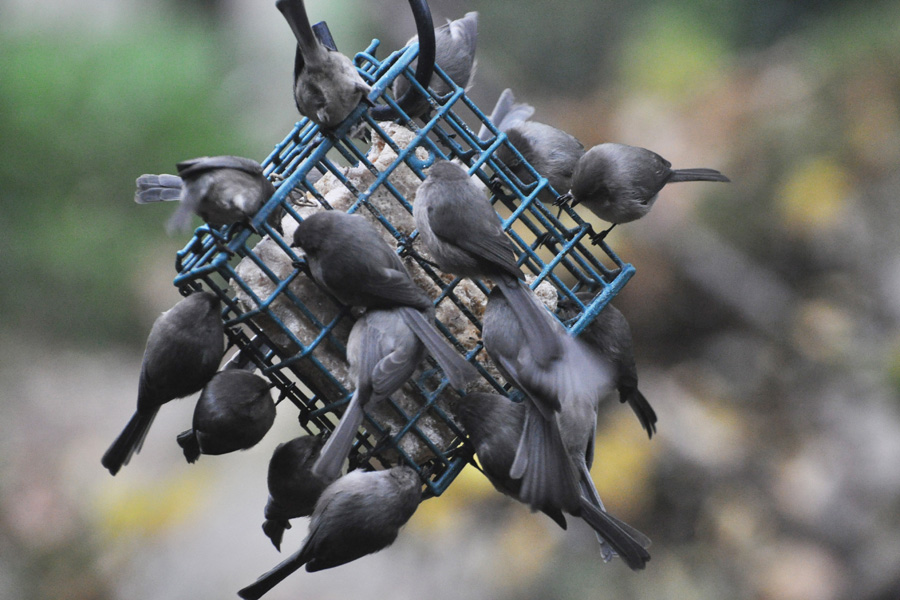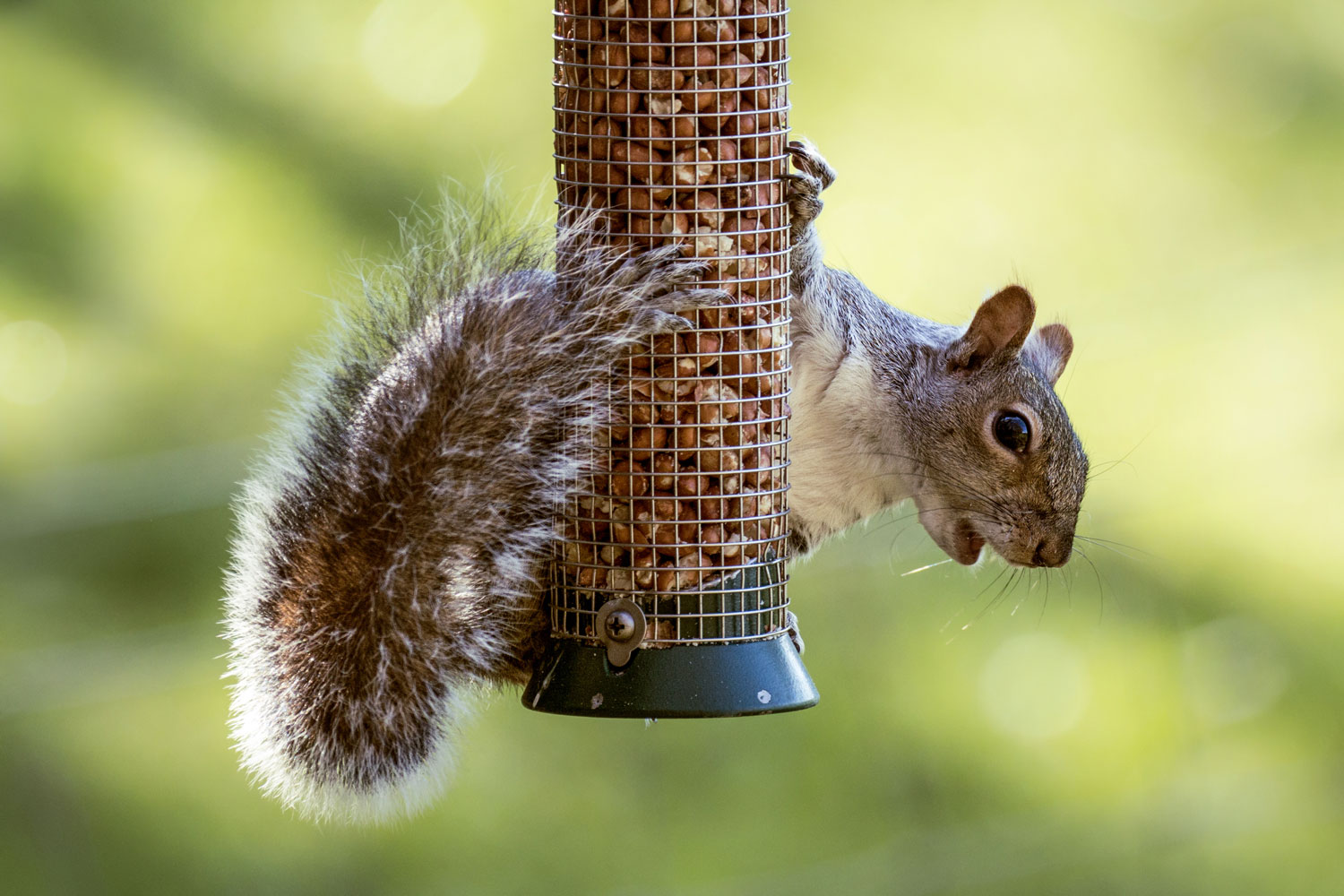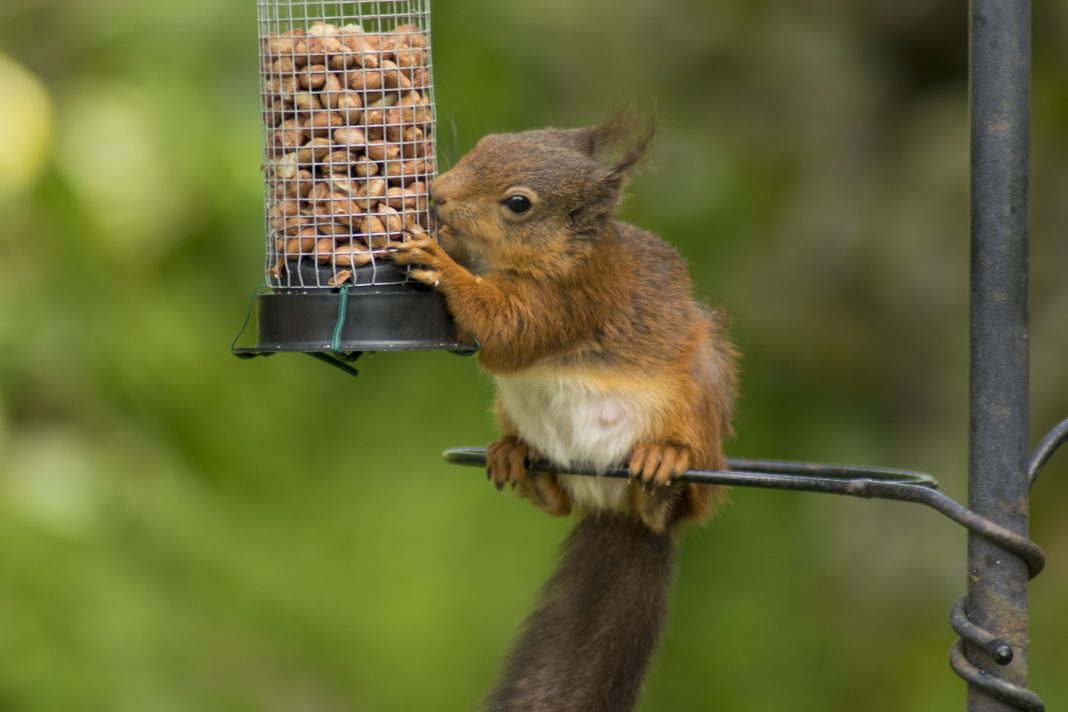BIRD FEEDER
In the whimsical dance of nature, where sunlight orchestrates the daily symphony, the question arises like a delicate flutter of wings: Can you put hummingbird feeders in the sun? Picture a sunlit garden, bathed in golden rays, as these tiny, iridescent avian acrobats zip and zoom with unparalleled grace. As keepers of the nectar-filled oasis, we find ourselves pondering the optimal stage for this aerial ballet. Join me on a journey through the sun-kissed realms of avian hospitality, where the allure of sunlight meets the delicate thirst of the hummingbird—a tale woven between the threads of nature’s grand tapestry.
Types Of Feeders
HUMMINGBIRD FEEDERS:
A hummingbird feeder is a device designed to attract and feed hummingbirds. Hummingbirds are small, colorful birds known for their rapid wing beats and ability to hover in mid-air. They have a high metabolism and feed on nectar from flowers, which provides them with the energy they need.
Hummingbird feeders are typically made of plastic or glass and consist of a container for holding a sugar solution that mimics the nectar found in flowers. The feeder usually has small feeding ports or tubes where hummingbirds can insert their long bills to access the nectar. The design of these feeders often includes bright colors to attract the attention of hummingbirds.

Here are the basic components of a hummingbird feeder:
- Container: This is where the sugar solution (nectar) is held. It is usually made of clear or colored plastic or glass.
- Feeding Ports: These are openings on the feeder where hummingbirds can access the nectar. They are designed to accommodate the length and shape of a hummingbird’s bill.
- Perches: Some feeders come with perches for hummingbirds to rest while feeding. Not all hummingbirds need perches, as many are capable of hovering while they feed.
- Hanging Mechanism: Hummingbird feeders are often designed to be hung from a hook or tree branch. This helps keep the feeder stable and within reach of hummingbirds.
The sugar solution used in hummingbird feeders is typically a mixture of water and white granulated sugar. It’s important to use the correct ratio of sugar to water to provide a solution that closely resembles natural nectar. Additionally, maintaining cleanliness is crucial to prevent the growth of harmful molds and bacteria.
Hummingbird feeders can be a delightful addition to gardens, allowing people to observe these fascinating birds up close. However, it’s important to be mindful of the potential impact on the birds’ natural feeding behaviors and ensure that the feeders are cleaned regularly to promote the birds’ health.
SEED FEEDERS:
A seed feeder is a device designed to attract and feed birds by providing them with seeds. These feeders are commonly used by bird enthusiasts to attract a variety of bird species to their gardens, yards, or outdoor spaces. Seed feeders come in various designs, and the type of seeds they dispense often determines the types of birds they attract. Here are some common types of seed feeders:
Hopper Feeders:
These feeders have a container or hopper that holds a large quantity of seeds. The seeds gradually flow into a tray or feeding port as birds consume them. Hopper feeders are versatile and can attract a variety of bird species.
Tube Feeders:
Tube feeders consist of a cylindrical tube with feeding ports. Seeds are dispensed through small openings, and the design often prevents squirrels from accessing the seeds. These feeders are popular
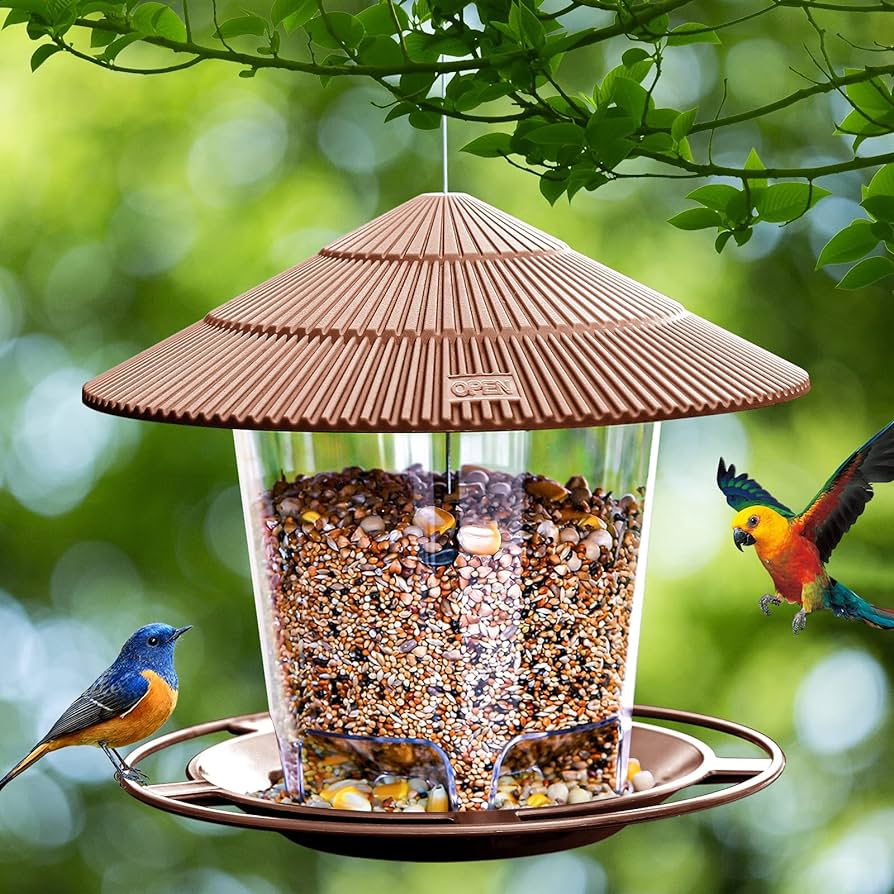 for attracting smaller birds like finches and chickadees.
for attracting smaller birds like finches and chickadees.
Platform Feeders:
Platform feeders have a flat surface where seeds are placed. They are suitable for a wide range of bird species, including ground-feeding birds like sparrows and doves. Platform feeders may have a roof or cover to protect the seeds from the weather.
Niger (Thistle) Feeders:
Niger feeders are designed specifically for dispensing tiny Niger seeds. These seeds are favored by finches, such as goldfinches and siskins. The feeders typically have small ports to accommodate the small size of Niger seeds.
Suet Feeders:
While not for seeds, suet feeders are worth mentioning. They hold blocks or cakes of suet, a high-energy food made from animal fat. Suet feeders attract insect-eating birds, especially during colder months when insects are scarce.
Ground Feeders:
Some people choose to scatter seeds directly on the ground to attract ground-feeding birds like sparrows, juncos, and doves. Ground feeders can be a simple and effective way to offer seeds to a variety of bird species.
When choosing a seed feeder, it’s essential to consider the types of birds you want to attract and the specific seeds they prefer. Additionally, keeping the feeders clean and regularly replenishing the seeds helps maintain a healthy and inviting feeding environment for the birds.
ORIOLE FEEDERS:
Oriole feeders are specialized bird feeders designed to attract and feed orioles, which are brightly colored, medium-sized songbirds. Orioles are known for their vibrant orange, yellow, and black plumage and are often found in North and South America. These feeders are designed to provide a food source that appeals to orioles’ preferences. Here are some common features of oriole feeders:
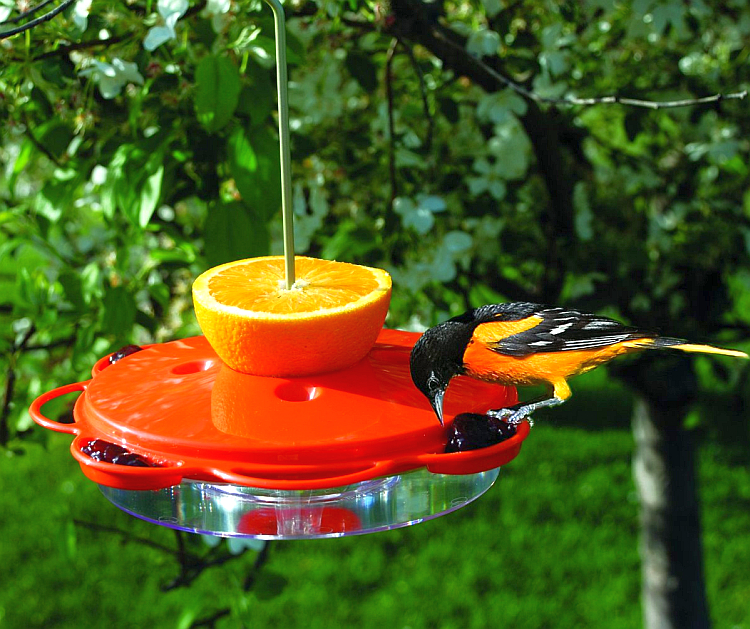
Bright Colors:
Oriole feeders are typically adorned with bright colors such as orange and yellow. Orioles are attracted to these colors, as they resemble the fruits and flowers that make up a significant part of their natural diet.
Nectar Ports:
Orioles are known to enjoy nectar, similar to hummingbirds. Oriole feeders often have ports or tubes designed for dispensing a sweet nectar solution. Some oriole feeders may have a perch or a place for orioles to rest while feeding.
Fruit Holders:
Many oriole feeders come with compartments for holding slices of orange or other fruits. Orioles are also attracted to the sugary juices of fruits, making this a popular feature.
Jelly Holders:
Orioles have a fondness for jelly, and some feeders are designed with holders specifically for offering grape jelly. Jelly provides additional energy and nutrients for these birds.
Multiple Feeding Ports:
Oriole feeders often have multiple feeding ports or stations, allowing several orioles to feed at the same time. This is especially important during the breeding season when there may be increased competition for food.
Easy to Clean:
Like any bird feeder, it’s essential to keep oriole feeders clean to prevent the growth of mold and bacteria. Look for feeders that are easy to disassemble and clean.
When filling oriole feeders, it’s common to use a nectar solution made from water and sugar, similar to hummingbird feeders. A mixture of 4 parts water to 1 part white granulated sugar is a standard ratio. Additionally, providing fresh fruit slices and jelly can help attract and meet the dietary preferences of orioles.
Setting up oriole feeders in your yard or garden can provide an opportunity to observe these beautiful birds up close and contribute to their well-being, especially during migration or breeding seasons.
SUET FEEDERS:
Suet feeders are designed to hold and dispense suet—a high-energy food source made from animal fat—providing essential nutrients for birds, especially during colder months when other food sources may be scarce. Suet is a valuable supplement for birds, offering them a good source of calories and helping them stay warm in winter.
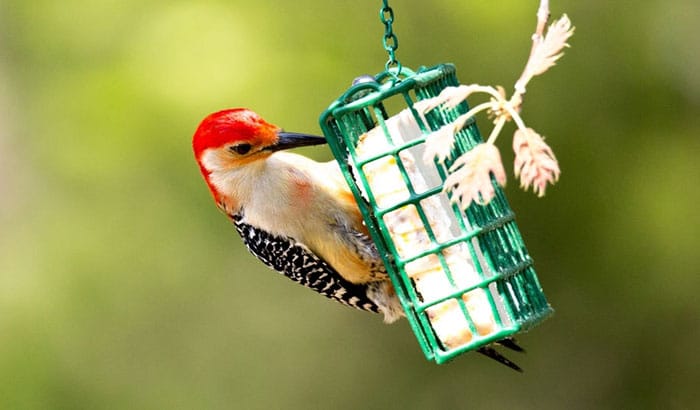
Here are some key features of suet feeders:
Wire Cage or Mesh Design:
Suet feeders typically have a wire cage or mesh design that holds suet securely while allowing birds to cling to it and feed. The cage helps prevent larger birds or squirrels from carrying away the suet block.
Suet Cake Holders:
Some suet feeders have dedicated compartments or holders for suet cakes. These cakes are often pre-packaged and may contain a variety of ingredients, including seeds, nuts, and insects, in addition to the suet.

Tail Prop or Perch:
Some suet feeders come with a tail prop or perch to accommodate woodpeckers and other clinging birds that prefer a stable platform while feeding.
Weather Protection:
Good suet feeders often include a cover or roof to protect the suet from the weather. This helps keep the suet fresh and prevents it from becoming rancid or moldy.
Easy to Clean:
Like any bird feeder, suet feeders should be easy to disassemble and clean. Regular cleaning is important to prevent the spread of disease among the birds.
Suet feeders are especially attractive to birds like woodpeckers, nuthatches, chickadees, and other insect-eating species. Some bird enthusiasts also add ingredients like seeds, fruits, or mealworms to homemade suet mixes to increase the variety of birds that visit the feeder.
To use a suet feeder, you can either purchase pre-made suet cakes or make your own suet mixture at home. Suet is typically a mix of rendered animal fat (beef suet is common) and other ingredients like birdseed, dried fruit, or insects. Ensure that the suet is free from additives such as salt or seasoning, as birds do not require these elements in their diet. Hanging suet feeders in your yard can be a great way to attract a diverse range of bird species, especially during colder seasons.
OTHER:
